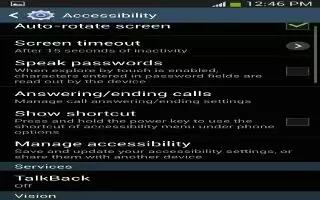Learn how to customize accessibility settings on your Samsung Galaxy Tab 3. Accessibility services are special features to make using the device easier for those with certain physical disabilities. Use the Accessibility settings to activate these services.
Note: You can download accessibility applications from Google Play and manage their use here.
- Touch Settings > Accessibility.
Configure the following settings.
- Auto-rotate screen: When this option is checked, the screen orientation changes when you rotate the device. When this option is not checked, the screen orientation locks in the current orientation (landscape or portrait) and the orientation does not change when you rotate the device.
Note: From any screen, touch the top of the screen and swipe downward, to display the Quick Settings screen. Touch Screen rotation to enable or disable the auto-rotate feature.
- Screen timeout: Select the screen delay time the screen delays shutting off after inactivity for the selected period of time.
- Lock automatically: This option only appears depending on the Screen lock setting. For more information, refer to Screen Lock .
- Speak passwords: Speaks passwords to enter them.
- Show shortcut: Set this option to display an Accessibility shortcut on the Device options pop-up when you press and hold the power key.
- Manage accessibility: Save and update your accessibility settings or share them with another device. You can export or import your accessibility settings to or from a file and then share the file with Email, Gmail, and so on.
Services
- Enable or disable accessibility services.
Note: You must activate Accessibility before enabling services.
- Touch Settings > Accessibility.
- Touch TalkBack to activate TalkBack.
Note: TalkBack, when installed and enabled, speaks feedback to help blind and low-vision users.
- Touch the OFF / ON icon to turn TalkBack on.
- Touch Settings to configure TalkBack.
Note: TalkBack can collect all of the text you enter, except passwords, including personal data and credit card numbers. It may also log your user interface interactions with the device.
Vision
To set vision options:
- Touch Settings > Accessibility.
Configure the following settings:
- Font size: Set the font size.
- Magnification gestures: Enable Magnification gestures and read more about using them. Touch the OFF / ON icon to enable this option.
- Negative colors: Set negative screen colors. When enabled, a check mark appears in the check box.
- Color adjustment: If the color of the screen makes it difficult for you to read the display, use this setting to adjust the colors of the screen. Touch the OFF / ON icon to enable this option. Touch Start to choose new display colors.
- Accessibility shortcut: Add a shortcut to Accessibility settings that displays when you press and hold the Power key. Read the displayed instructions. Touch the OFF / ON icon to enable this option.
- Text-to-speech options: To set voice output settings, touch Text-to-speech options and select the preferred TTS engine. For more information, refer to Speech Settings” Touch Speech rate to set the speed at which the text is spoken. Touch Listen to an example to play a short speech demonstration.
- Enhance web accessibility: Set this option to allow apps to install scripts from Google that make their Web content more accessible:
Hearing
To set hearing options:
- Touch Settings > Accessibility.
Configure the following settings:
- Sound balance: When you are using a stereo device, touch the Sound balance field and use the slider to adjust the balance. Touch Set to save the setting.
- Mono Audio: When Mono audio is enabled, you can listen through one earphone to mono audio sound. When enabled, a check mark appears in the check box.
- Turn off all sounds: Turn off all sounds including receiver voice. When enabled, a check mark appears in the check box.
Mobility
To set mobility options:
- Touch Settings > Accessibility.
Configure the following settings:
- Assistant menu: Turn on functions to improve device accessibility for users with reduced dexterity. Touch the OFF / ON icon to enable this option. Touch Dominant hand to set right or left hand. Touch Edit to customize the menu.
- Press and hold delay: This option allows you to set the Press and hold delay time.
Recognition
To set recognition options:
- Touch Settings > Accessibility. Next to Interaction control, touch the OFF / ON icon to enable this option.
- Touch Interaction control and read the displayed instructions.
Note
This guide will work on all Samsung Galaxy Tabs; including Samsung Galaxy Tab 3 7.0, Samsung Galaxy Tab 3 8.0 and Samsung Galaxy Tab 3 10.1.
